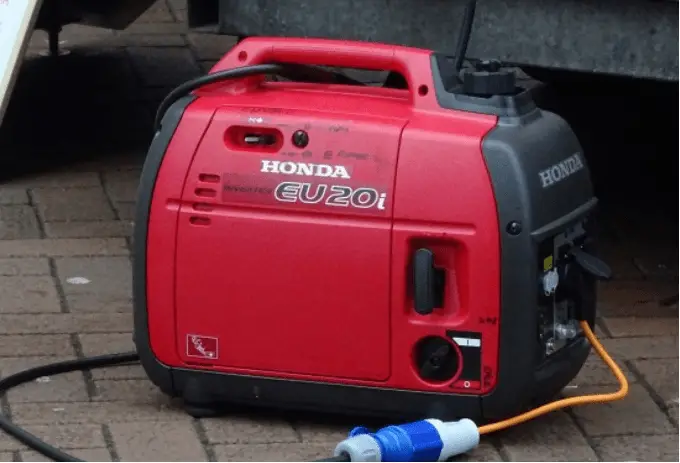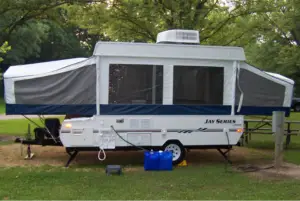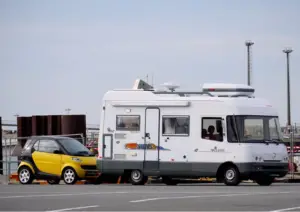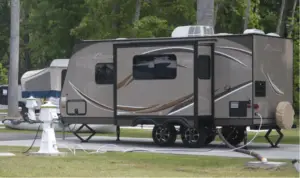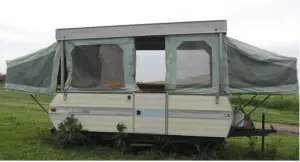RV generators keep you powered no matter how far you travel with your RV.
With the right generator, you and your family will be able to experience the comforts of your home out there in the campground. Whether you want to cook, stay entertained, or recharge your devices, during camping, you will need an RV generator to power up.
Knowing how things work in your RV will always keep you prepared. Its no surprise that many newbies don’t fully understand electrical setup in the RV.
In this article, we will check out the operation and setup of a RV generator.
How does a RV Generator Work
When traveling with your RV, it is essential to understand how your RV generator works. This is to ensure that the generator is there for you when you need power.
Firstly, the generator has to start easily and quickly. Then it should run efficiently, smoothly, and automatically.
RV generator provide 120-volt power when camping in a campsite with no electrical hookup or while travelling. It can power all your electrical appliances with 120-volt current and electric outlets in the RV with 120 volts.
With generator power, you will be able to plug your appliances and devices such as air conditioners, refrigerator, phones, computers, electric kettles, etc.
An inbuilt generator uses the fuel from your RV to run. Therefore, you do not need to carry extra fuel for your generator. The amount of fuel it will use depends on its size and the amount of load you put on the generator.
If you have a lot of electric appliances in the RV, the generator will consume more fuel. It is essential to note that your RV generator will consume an average of one gallon of fuel when running for one hour.
When there is only a quarter of fuel in the RV fuel tank, the generator will automatically shut down. This is to ensure that there is still enough fuel for you to be able to drive your RV. Most RV fuel tanks can hold up to 50 to 100 gallons of fuel, depending on the size of the RV.
You can easily turn on and shut it down easily through a switch located on the panel. When filling the generator with fuel, you should ensure it’s turned off for safety purposes.
Starting RV Generator
If you are an RV owner, it is vital to understand how to start the RV generator. If you want to have an easy time starting, ensure it gets routine maintenance.
There are starting procedures that you need to follow when starting it. These procedures apply to both automatic and portable generators.
Automatic generators are those that are inbuilt, and portable generators are not installed by the manufacturer.
In this section, we shall discuss how to start an onboard and a portable RV inverter generator.
Starting an onboard RV generator is quite simple. Most RV models will require you to first access the generator through the storage bay doors where the RV generator is located.
This is because onboard generators run using the same fuel that is used by your RV’s engine. They rely on the fuel source supplied through your RV engine fuel system, and therefore you should understand how they are assembled and their safety features.
Before you start the generator, you should check the fuel level. This is because if your RV fuel tank reaches below one-quarter of fuel, it will not supply any fuel to the generator.
Starting the generator properly is essential to be able to power appliances and preventing damages to the generator. Following these steps will help you start your RV generator effectively each time.
Step 1
The first step to starting your onboard camper generator is to locate the control buttons, which include the primer and the starter button. These buttons are located next to each other.
Moreover, there are rocker switches that connect to the generator starter motor when you put pressure on your finger, and they spring out again when you release the pressure from your finger.
Step 2
The next step is to read the RV owner’s manual carefully. This will help you learn everything about the controls of your generator and to keep the generator working efficiently.
The manual will also help you to know if there is an inline fuel stop tap that is fitted on the generator. This fuel stop tap can block the flow of fuel from the camper tank to the generator. If it is fitted, make sure you change it in the open position.
Step 3
Thirdly, you need to check the fuel level in the supply tank. Onboard generators are fueled directly from the RV tank. Checking the level of fuel in the tank ensures that the generator does not consume all the fuel meant to run the RV.
Step 4
In this step, you need to ensure that all high-demand power appliances such as air conditioners are switched off before starting the generator for safety purposes.
Step 5
In this step, you can now start the onboard generator. You will need to first prime your RV generator by pushing the prime button about two to three times. Then press the start button down until the motor starts.
However, if the generator does not start even after holding the start button down up to four times, make sure you repeat the process several times.
Starting a Portable Generator
For portable generators, the process of starting is almost similar to the onboard generator. With portable generators, you will need first to remove the generator from your RV, fill with fuel, and plug it into a power supply.
Portable RV inverter generators are noisier than onboard generators. Therefore, when starting a portable generator, ensure you are away from your commonly used living spaces. Additionally, they may produce some exhaust when starting.
Here are steps to follow when starting a portable RV inverter generator.
Step 1
When it comes to portable RV generators, you need to always check the level of oil before starting the generator.
If the oil level is low, you will need to prime it again to start. To locate the priming button, consult the operator’s manual as well as to familiarize yourself with other specifics.
Step 2
Once you are familiar with the portable generator, you should now start it. Most portable RV generators will require you first to prime the carburetor.
This is because most of the portable generators do not have an electric ignition system. Therefore, you will need to prime the motor and then pull the recoil cord. The recoil cord is located either on the side or at the top of your generator.
Make sure you follow the manufacturer’s guide to prime your generator. Once you pull the recoil cord, the generator will start. Sometimes, the generator may not start with the first pull; hence you need to repeat the process until it starts running.
What Things Can a Generator Power in RV?
RV generators can power almost everything in your RV. When traveling, especially in remote campsites with no electric power, you need to ensure that your RV generator will provide you with all the power you need.
RV generators can power from high power consumption appliances to small electronics in the RV. They include air conditioner, cooler or refrigerator, microwave, vacuum cleaners, heating, and cooling systems.
Other things that can be powered by RV generators include TV, computers, coffee makers, hairdryers, and charging phones.
Built-in vs Portable
When purchasing RVs, most of them will come with built-in generators, while some you will need a portable generator to power up your RV. The two types of RV generators are different in various ways.
Built-in generator produces high watt output than portable generators, which is essential in ensuring that everything in the RV is powered. This is not the case with portable RV generators since they produce low watt output that cannot be able to power some power-hungry air conditioners.
Another difference is that built-in generators are easy and convenient to use. You only need to push a button to start it. But with a portable generator, you will need to make connections and plugs to start the generator.
Portable generators tend to be clean compared to built-in generators. This makes them more efficient, less noisy, and less costly. On the other hand, it can be difficult to service built-in generators regularly; thus, they make more noise, and they are not as clean as portable generators.
Placing the portable generators
Most travel trailers wont have an onboard generator. In such a case, getting a portable generator is your best option which can be placed on top of the propane tank using an A-Frame carrier or even behind the propane tank. Front mounted generators on travel trailers are more secured as compared to the rear side.
When you are using a portable generator place it far away from the RV. You can keep it as far as 20 feet using the cord extension. Also, make sure the exhaust is facing in the direction away from your travel trailer. Placing it far also means less noise to your ears.
Size of the generator you need for your camper will depend on the appliances you want to run. Bigger appliances like air conditioner need high wattage for starting and based on these watts requirements you need to select the watts for your generator.
Some of the top portable RV generator brands include:
- Honda
- Yamaha
- WEN
- Champion
- Westinghouse
- Briggs and Stratton
Noise and Fuel
Most RV generators make noise between 48 db to 65 db. This can be irritating if you are not used to such generator noise. However, most modern portable generators are quite enough and will not bother you much or even your neighbors in the campground.
RV generators use 3 different types of fuel. They include gasoline, liquid propane, and diesel. It is recommended that if your RV runs on diesel, you should also buy a diesel-run RV generator.
Running hours
You can safely run your RV generator for about 8 to 20 hours. This will depend on the model, proper maintenance, and generator type. Built-in generators can safely run for many hours to several days.
If you are using a lot of electric appliances in your RV, the generator will use more fuel. On average, an RV generator will use about one gallon of fuel for every hour of operation.
When the built generator runs for long hours it can get hot specially when there is lack of ventilation and air flow inside the RV.
It is essential that you run the RV generator often even during off season. You need to run the RV generator at least for an hour every month so as to keep it in good condition and avoid fuel gumming. This applies even to high quality generators.
It is not advisable to run the generator at night in a motorhome when everyone is sleeping. Built and even portable generators can produce Carbon monoxide which can result in serious problems specially when the RV does not have proper ventilation. Make sure you have functioning CO detectors installed in the RV.
One can run an inbuilt generator while driving a motorhome but with added safety precautions. If the generator is a propane fueled then it may not be allowed by laws in some states specially at the gas stations.
Don’t want a generator in your RV because of the noise, exhaust, CO , weight or fuel? Here are your alternative power options:
- Use campground shore power while at the campground.
- Go solar while boondocking or dry camping. Install solar kits, this can power almost everything in the RV.
- Use multiple DC batteries to power most of the appliances.
- Propane to run the refrigerator and furnace.
But, honestly speaking, generator is a must when you are not connected to a campground electricity hookup.
Conclusion
Knowing how a generator works will help you in learning the next step and that is troubleshooting it whenever issues arise. So, next time when your generator shuts off and wont turn on you wont spend hours figuring it out.

